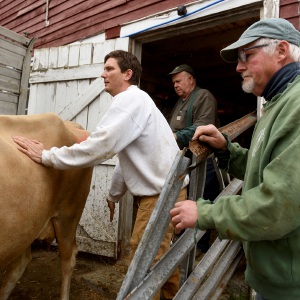Enterprise: Upper Valley pet sitters discuss business growth, needs
| Published: 04-15-2024 1:51 PM |
CORNISH — Liz Gage liked the idea of starting a pet sitting service but never considered it a way to make a living — until she met someone who did.
Gage, of Cornish, who was working in health care at the time, then began doing her own research to see if it was feasible for her to do the same. She picked up a book on the topic of pet sitting, created forms and put together a business plan before launching Creature Companion in 2005.
Today, Gage serves about 80 clients a year in Cornish and neighboring towns. She looks after a variety of animals, including dogs, cats, goats, sheep and guinea pigs.
Creature Companion is one of several pet sitting services in the Upper Valley, and Gage is chairwoman of the Professional Pet Sitters of the Upper Valley, a group of five pet sitters who meet to share ideas and also work in partnership with each other to provide the best care possible for pets in the area. The network is also a resource for pet owners looking for pet services including medical care, adoption, training and grooming.
“We certainly need more pet sitters in the Upper Valley,” Gage said. She initially reduced her health care job to part-time after she started her business. Then she was able to leave it entirely after a year and make a living as a full-time pet sitter. “It took me about three years to get my client base established.”
The U.S. pet sitting industry was valued at $700 million in 2022 and is projected to grow 10.4% annually through 2030, according to Grand View Research, a California-based market research company. More than 80% of the market is for dogs, with cats the next-largest group.
Pet Sitters International in North Carolina and The National Association of Pet Sitters in Huron, Ohio, provide members with an array of services, including a certification course for pet sitters, advice on running a pet sitting service and insurance. More than 95% of PSI members care for cats or dogs, 75% small mammals, 73% birds and 70% freshwater fish.
While pet sitting requires — above all else — a love of animals, that is only one part of running a successful pet sitting service, said Cathy Delaney, director of the National Association of Pet Sitters.
Article continues after...
Yesterday's Most Read Articles
 Herd departs Hartford’s last remaining dairy farm
Herd departs Hartford’s last remaining dairy farm
 Bald eagles are back, but great blue herons paid the price
Bald eagles are back, but great blue herons paid the price
 At Dartmouth, hundreds protest ongoing war in Gaza and express support for academic freedom
At Dartmouth, hundreds protest ongoing war in Gaza and express support for academic freedom
 Kenyon: What makes Dartmouth different?
Kenyon: What makes Dartmouth different?
 A Life: Richard Fabrizio ‘was not getting rich but was doing something that made him happy’
A Life: Richard Fabrizio ‘was not getting rich but was doing something that made him happy’
“Do they love animals? Yes, but that doesn’t make someone a professional pet sitter,” Delaney said. “They need to research things like a business license, insurance and bonding.” Bonding is the method by which pet sitters themselves are insured against a lawsuit by a client, as opposed to insurance for the business as a whole.
Certification courses cover the business side as well as pet care, health, nutrition, pet safety and first aid. Neither Vermont nor New Hampshire require certification, but some states do.
“We try to provide them with the tools that help them with their business,” Delaney said. “Communicate with your local government to see what your state requires. That is a good place to start. Most states do not require a certification but do require a business license.”
Gage, a member of Pet Sitters International, registered her business name with the state; nothing else was required for her to begin advertising for clients. She obtained insurance and bonding and is certified in pet first aid and CPR.
There was a time that, when people needed someone to care for a pet while they were away, they could ask a neighbor or, for dogs, drop them at the local kennel. Today, many rely on pet sitters for several reasons.
Benefits for the pets include being in their own environment, surrounded by familiar sights and sounds, following a regular diet and exercise routine and having play time. Pet owners also have peace of mind about their pet when they are not home.
Pets association members care for “rodents, hermit crabs, llamas and lots of chickens,” Delaney said. “It is no longer just cats and dogs.”
Randy Ries, co-owner of Critter Sitters in Quechee, remembers getting strict instructions from the owner of a tarantula.
“She really put me through the paces on what to do,” said Ries, who got into the business in 2004.
Gage said the best pet sitters go beyond the basics of feeding and cleaning a cage when they visit the home of a pet and will interact with them.
“They are patient, always willing to learn from the pets in their care, and they treat them with respect,” Gage said. “I will hang out with them, let them crawl up into my lap if they want to, or I will get out toys to play with.
“A good pet sitter searches for ways to improve their work through education and they are reliable, dependable and trustworthy.”
Molly O’Dwyer, owner of Molly O’s Pet Care LLC in Hartford, said keeping up on training is a key piece to being a professional pet sitter.
“We find pride and responsibility in keeping educated about different training techniques and keeping up with things like first aid and CPR,” said O’Dwyer, who has cared for cats, dogs, horses, snakes, guinea pigs, fish and parrots over her seven years in business.
O’Dwyer grew up around lots of animals and had a few jobs associated with animals, including at the Monadnock Humane Society, which she said gave her appropriate skills to handle other people’s pets.
“It takes an observant person to notice when things are off with an animal but also for a client’s property and home,” O’Dwyer said. “If you are going to do it professionally, it is not just liking cats and dogs. You may have to give medicine to an angry cat or find it when it is hidden. Some animals are anxious when their owners are not around.”
To get started, O’Dwyer — who is bonded, insured and certified in pet first aid and CPR — joined Pet Sitters International and met with a member of SCORE (Service Corps of Retired Executives) to help her set up the business side, including filing taxes. She urges anyone thinking of pet sitting to meet with an accountant to decide on the form of the business and cultivate relationships with others in the pet care field, from veterinarians to groomers and dog trainers. Gage also recommends talking to and shadowing a pet sitter to get a feel for the business and picking up the book “Pet Sitting for Profit,” by Patti Moran.
Like others starting a small business, health insurance is another thing to consider, O’Dywer said, because pet sitters can be bitten or injured.
Professional pet sitters have service contracts with their clients that usually cover in detail the history of the pet from its age, how old it was when they brought it home, its behavior and its health history. Service rates can vary depending on the agreed-upon obligations of the pet sitter. These can include the length of the visit, feeding, medication, grooming and walking.
Ries, of Critter Sitters, said attention to details about a pet’s behavior is important.
“This is not just a skip down the road to walk a dog. If a client tells you the dog must stay on the leash, then keep it on the leash,” Ries said, adding that he knew of a situation when that did not happen and the dog was hit and killed by a car.
Ries also said pet sitter contracts should spell out liabilities and which party is responsible, particularly for damage in the home while the sitter is inside.
“I go over it with them and make sure everything is crystal clear,” Ries said.
While Gage and O’Dwyer said their businesses are doing well, Ries said his client base went from about 200 pre-COVID to around 30 today. He said many pet owners started working remotely and, in other cases, children moved back home and could take care of the animals. Instead of visiting a client five days a week, Ries said it can be just a couple of times.
“It came back, but it is jagged,” he said.
Like any small business owner, Gage said she has her ups and downs and the demands of being there when needed can make balancing work and life difficult. But the rewards of seeing the pets are far more beneficial.
“Everyday when I open the door to a client’s home, I’m greeted with happiness,” Gage said. “Additionally, I love the relationships I have developed with the human clients.”
Patrick O’Grady can be reached at pogclmt@gmail.com.

 Big drop in tuition and aid is boosting Colby-Sawyer
Big drop in tuition and aid is boosting Colby-Sawyer  How NH Education Commissioner Frank Edelblut used his office in the culture war
How NH Education Commissioner Frank Edelblut used his office in the culture war
